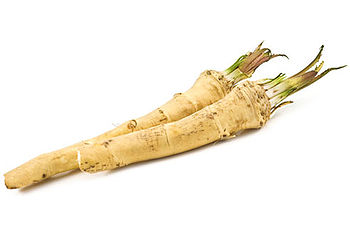Other Names: Amoraciae Rusticanae Radix, Armoracia lopathifolia, Armoracia rusticana, Cochlearia armoracia, Cran de Bretagne, Cranson, Grand Raifort, Great Raifort, Meerrettich, Mountain Radish, Moutarde des Allemands, Moutarde des Capucins, Moutardelle, Nasturtium armoracia, Pepperrot, Rábano Picante, Rábano Rústico, Radis de Cheval, Raifort, Raifort Sauvage, Red Cole, Rorippa armoracia., mierikswortel
Horseradish (Armoracia rusticana) is a strong seasoning successfully used in phytotherapy. Because of its spicy flavor the horseradish root is used in conserving the canned food for the winter but is also used throughout the year in preparing various meal recipes. It originated in south-eastern Europe and western Asia and it is resistant to the low temperatures as well as to droughts. This herb grows in the shaded places as well as the warm ones but it does not grow on sandy soils, however argillaceous alkaline soils rich in humus are ideal for horseradish. It can grow up to 2m; it has large edible leaves and a branched stem.
See also : Cruciferous Vegetables
Special Precautions of Horseradish
The consumption of horseradish is not advisable to the individuals suffering from gastric ulcer, goitrous problems or renal illnesses. Also the consumption of horseradish is forbidden to children younger than 4 years old.
The benefits of Horseradish are
As a medicine horseradish root has many curative properties: strong antibiotic, expectorant, bronchodilatator, antibacterial, coronary vasodilatator, it increases the blood pressure, it heats up the body, stimulates the body's immune system, anti-inflammatory, antiparasitic, antianemic, antiscorbutic, diuretic. It can stimulate the appetite. It has a cardiotonic effect and is recommended to the people that suffer from high blood pressure. Also it is known that horseradish has aphrodisiacal properties.
- Antibiotic : Horseradish contains a volatile oil called sinigrin, which is broken down in the body to produce allyl isothiocyanate – a powerful natural antibiotic. There are various other extremely active healing compounds contained within this spice that help clear congestion, thin down mucus, reduce inflammation and fight infections.
- Bronchitis, sinusitis, paradontosis, rheumatism, anemia, flu, stomatitis, and even facial paralysis can be treated by using horseradish. As for sinusitis and rhinitis it is enough for a cataplasm to be placed on the forehead along with two spoons of grained horseradish so that the nose gets immediately decongested. This treatment is repeated 4 to 5 days in a row and it gets interrupted once burns occur.
- Against bronchitis, flu and lung congestions, horseradish flour is applied like a cataplasm on the chest area for a half an hour up to an hour. This treatment is repeated once every two or three days.
- Pains caused by rheumatism disappear if a cataplasm of horseradish is used. If a burning sensation appears the treatment is to be stopped.
- Gargling tincture of horseradish dosed in 3-4 spoons in a glass half filled with water alleviates stomatitis.
- Against paradontosis, the person suffering from it would need to chew grained horseradish. It can be mixed with carrots to reduce the spicy taste. This herb is great for gums because of its strong stimulating effects.
- Horseradish syrup is recommended in cases of asthma, bronchitis, breathing disorders.
- Bladder Cancer : Wasabi (a root vegetable from Wasabia japonica that is ground into a paste), mustard and horseradish help to produce large amounts of AITC (Allyl isothiocyanate).
- Candidiasis : It turns out horseradish may be an effective candida killer. Like garlic, horseradish targets the glutathione in candida cells, rapidly killing them, according to a study published in the Journal of Basic Microbiology. To harness horseradish’s candida-slaying ability avoid the grocery store junk. It’s typically packed with sugar (both candida and cancer thrive on sugar). Make your own using fresh horseradish root instead. Stir some into burgers, meatloaf, tuna salad, deviled eggs or even mashed cauliflower.
